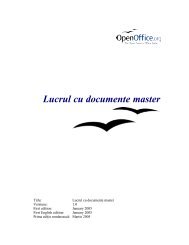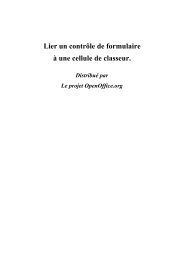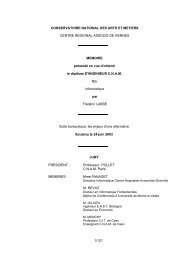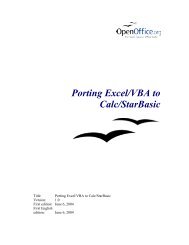StarOffice Calc v. MS Excel: - SVN
StarOffice Calc v. MS Excel: - SVN
StarOffice Calc v. MS Excel: - SVN
You also want an ePaper? Increase the reach of your titles
YUMPU automatically turns print PDFs into web optimized ePapers that Google loves.
<strong>StarOffice</strong> <strong>Calc</strong> Usability Evaluation<br />
Context of Product Use in the Test<br />
Tasks<br />
We presented our participants with two major scenarios, one for <strong>Excel</strong> and one for <strong>StarOffice</strong> <strong>Calc</strong>.<br />
These scenarios included four discrete stages: basic formatting, adding formulas to cells, advanced<br />
formatting, and adding charts.<br />
Since we felt that appropriate task selection was important to the success of our study, we made<br />
use of several resources in choosing a task set. We examined each spreadsheet’s Help sections<br />
and marketing materials [1] to determine what the developers felt were the most important tasks.<br />
We also asked current <strong>Excel</strong> users to describe the tasks they performed frequently. Finally, we<br />
used our personal experience with <strong>Excel</strong> to help shape the tasks.<br />
At the test commenced, the computer screen displayed a set of base data in either <strong>Excel</strong> or<br />
<strong>StarOffice</strong> <strong>Calc</strong>. The test administrator then showed the participant a stage illustration, a sheet of<br />
paper that showed the base data with significant formatting or calculation alterations (see Appendix<br />
D for stage illustrations). The administrator asked the participant to change the base data on the<br />
screen to make it look like the data on the paper. Once the participant had completed all the tasks<br />
in the stage, the administrator showed him or her the same data set with more alterations. The<br />
participant again manipulated the base data until it appeared like the data on the sheet. After<br />
completion of all four stages, the participant was asked to repeat a similar set of tasks in the other<br />
spreadsheet with slightly different data.<br />
We considered a task complete when the participant’s spreadsheet substantially resembled the<br />
stage illustration with respect to the task. If a participant did not notice that s/he had neglected to<br />
complete a certain task, we prompted him/her to perform the task. We considered a stage<br />
complete when the participant had either completed all tasks or indicated that s/he was not going to<br />
finish the remaining task(s). The participants themselves decided when to abandon a particular<br />
task.<br />
Test Facility and Computing Environment<br />
The participants were tested in a computer lab at the University of California, Berkeley. The lab had<br />
a low to medium noise level during the test. This environment is equipped with cubicles and<br />
standard office equipment; it resembles a workplace environment. The test equipment and setup is<br />
described in Table 3.<br />
Eklund, Feldman, and Trombley, 12/11/2001 8 of 54














